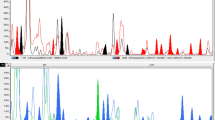Abstract
A representative set of germplasm of genusVigna subgenus Ceratotropis specieswas used to analyze genetic diversity using amplified fragment lengthpolymorphism (AFLP) methodology. The germplasm was selected based onmorphological diversity and geographic origin and includes 18 out of the 21species in the subgenus Ceratotropis. Genetic diversitywithin and between taxa was measured using information generated by AFLP bandpolymorphism from which Jaccard's similarity coefficient and nucleotidediversity were estimated. The data were also used to generate phenograms tovisualize relationships among analyzed accessions. All species in sectionsCeratotropis and Aconitifoliae arewell separated. However, most of the species in sectionAngulares show a high level of similarity suggesting a lowlevel of genetic differentiation. In section Angulares onespecies, V. trinervia, is welldifferentiated from the other species and represents a separate evolutionarybranch between section Ceratotropis and other species insection Angulares. The relationships between the newlydescribed species V. aridicola,V. exilis, V.nepalensis and V.tenuicaulis and other species in the subgenusCeratotropis are described for the first time based on AFLPdata.
Similar content being viewed by others
References
Arora R.K. and Nayar E.R. 1984. Wild relatives of crop plants in India. NBPGR Scientific monograph no. 7, New Dehli, India.
Dellaporta S.L., Wood J. and Hicks J.B. 1983. A plant DNA mini preparation: version II. Plant Mol. Biol. Rep. 1: 19–21.
Doi K., Kaga A., Tomooka N. and Vaughan D.A. 2002. Molecular phylogeny of genus Vigna subgenus Ceratotropis based on rDNA ITS and atpB-rbcL intergenic spacer of cpDNA sequences. Genetica 114: 129–145 (in press).
Fatokun C.A., Danesh D., Young N.D. and Stewart E.L. 1993. Molecular taxonomic relationships in the genus Vigna based on RFLP analysis. Theor. Appl. Genet. 86: 97–104.
Felsenstein J. 1992. Phylogenies from restriction sites, a maximum likelihood approach. Evolution 46: 557–574.
Innan H., Terauchi R., Kahl G. and Tajima F. 1999. A method for estimating nucleotide diversity from AFLP data. Genetics 151: 1157–1164.
Jaccard P. 1908. Nouvelles recheres sur la distribution florale. Bull. Soc. Vau. dSci. Nat. 44: 223–270.
Kaga A., Tomooka N., Egawa Y., Hosaka K. and Kamijima O. 1996. Species relationships in the subgenus Ceratotropis (genus Vigna) as revealed by RAPD analysis. Euphytica 88: 17–24.
Konarev A.V., Tomooka N. and Vaughan D.A. 2002. Proteinase inhibitor polymorphism in the genus Vigna subgenus Ceratotropis and its biosystematic implications. Euphytica (in press).
Mimura M., Yasuda K. and Yamaguchi H. 2000. RAPD variation in wild, weedy and cultivated azuki beans in Asia. Genet. Resour. Crop Evol. 47: 603–610.
Ng N.Q. and Monti L.M. 1990. Cowpea Genetic Resources. International Institute of Tropical Agriculture, Ibadan, Nigeria, 200 pages.
Potokina E., Tomooka N., Vaughan D.A., Alexandrova T. and Xu R.Q. 1999. Phylogeny of Vicia subgenus Vicia(Fabaceae) based on analysis of RAPD's and RFLP of PCR-amplified chloroplast genes. Genet. Resour. Crop Evol. 46: 149–161.
Potokina E., Vaughan D.A., Eggi E.E. and Tomooka N. 2000. Population diversity of the Vicia sativa agg. (Fabaceae) in the flora of the former USSR deduced from RAPD and seed protein analysis. Genet. Resour. Crop Evol. 47: 171–183.
Rohlf F.J. 2000. NTSYSpc: Numerical taxonomy and multivariate analysis system. Version 2.1. Users Guide. Exeter Software, Setauket, New York, 38 pages.
Tateishi Y. 1985. A revision of the Azuki bean group, the subgenus Ceratotropis of the genus Vigna (Leguminosae), PhD, Tohoku University, Japan.
Tomooka N., Lairungreang C. and Egawa Y. 1996. Taxonomic position of wild Vigna species collected in Thailand based on RAPD analysis. In: Srinives P., Kitbamroong C. and Miyazaki S. (eds), Mungbean Germplasm: Collection and Utilization for Breeding Program. Japan International Research Center for Agricultural Science, Japan, pp. 31–40.
Tomooka N., Egawa Y. and Kaga A. 2000 a. Biosystematics and th genetic resources of the genus Vigna subgenus Ceratotropisi 7 MAFF International Workshop on Genetic Resources. Wild legumes. National Institute of Agrobiological Resources, Tsukuba, Japan., pp. 37–62.
Tomooka N., Kashiwaba K., Vaughan D.A., Ishimoto M. and Egawa Y. 2000 b. The effectiveness of evaluating wild species; searching for sources of resistance to bruchid beetles in the genus Vigna subgenus Ceratotropis. Euphytica 115: 27–41.
Tomooka N., Vaughan D.A., Xu R.Q., Kashiwaba K. and Kaga A. 2001. Japanese native Vigna genetic resources. Jpn Agric. Res. Q. 35: 1–9.
Tomooka N., Vaughan D.A., Moss H. and Maxted N. 2002 a. The Asian Vigna. The genus Vigna subgenus Ceratotropis genetic resources. Kluwer Academic Press. (in press).
Tomooka N., Maxted N., Thavarasook C. and H A. 2002 b. Two new species, new species combinations and sectional designations in Vigna subgenus Ceratotropis (Piper) Verdcourt (Leguminosae, Phaseoleae). Kew Bull. accepted.
Vaillancourt R.E. and Weeden N.F. 1993. Chloroplast DNA phylogeny of Old World Vigna (Leguminosae). Syst. Bot. 18: 642–651.
Vaughan D.A., Tomooka N., Kaga A., Doi K. and Yoon M.S. 2000. Research on Vigna subgenus Ceratotropis genetic resources that provides insights into in-situ conservation strateth gies. 7 MAFF International Genetic Resources Workshop, In-situ Conservation Research. National Institute of Agrobiological Resources, Tsukuba, Japan, pp. 129–150.
Vos P., Hogers R., Bleeker M., Rijans M., Van de Lee T., Hornes M. et al. 1995. AFLP. a new technique for DNA fingerprinting. Nucleic Acids Res. 3: 4407–4414.
Xu R.-Q., Tomooka N. and Vaughan D.A. 2000. AFLP markers for characterizing the azuki bean complex. Crop Sci. 40: 808–815.
Yee E., Kidwell K.K., Sills G.R. and Lumpkin T.A. 1999. Diversity among selected Vigna angularis (azuki) accessions on the basis of RAPD and AFLP markers. Crop Sci. 39: 268–275.
Yoon M.S., Doi K., Kaga A., Tomooka N. and Vaughan D.A. 2000. Analysis of the genetic diversity in the Vigna minima complex and related species in East Asia. J. Plant Res. 113: 375–386.
Zink D., Schumann K. and Nagl W. 1994. Restriction fragment length polymorphisms of the phytohemaglutinin genes in Phaseolus and Vigna (Leguminosae). Plant Syst. Evol. 191: 131–146.
Author information
Authors and Affiliations
Corresponding author
Rights and permissions
About this article
Cite this article
Tomooka, N., Yoon, M.S., Doi, K. et al. AFLP analysis of diploid species in the genus Vigna subgenus Ceratotropis . Genetic Resources and Crop Evolution 49, 521–530 (2002). https://doi.org/10.1023/A:1020954800107
Issue Date:
DOI: https://doi.org/10.1023/A:1020954800107




